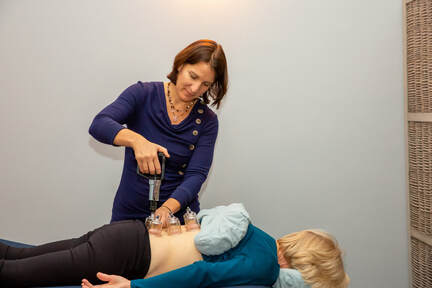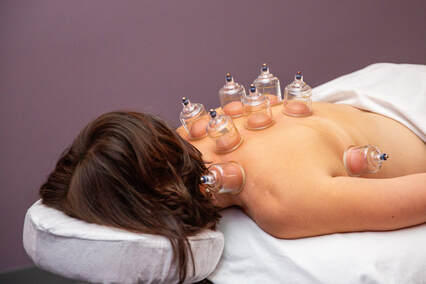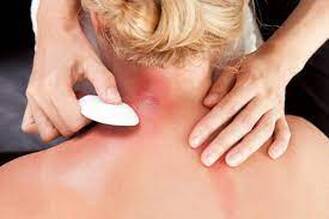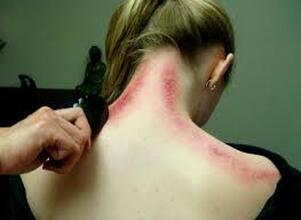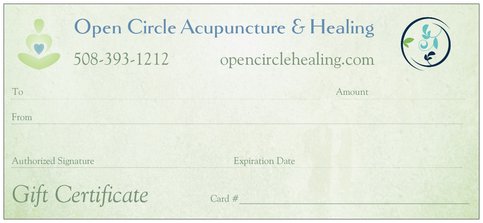What is Cupping and How Can It Enhance Your Health?
Cupping is an ancient form on therapy in which suction cups are placed on areas of the body to assist in moving circulation, relieving inflammation and releasing toxins. According to Traditional Chinese Medicine (TMC), cupping is a powerful way to break up blood and Qi (pronounced chee) stagnation.
When the cups are placed on areas of the body, usually on the back, the marks left by the cups can vary from a very light pink, to red or even purple. The more chronic the tightness and pain is in that area of the body, the darker and deeper the cupping marks can be. The cups are generally left on the body for about 5 to 20 minutes. Besides being therapeutic, the cupping session can be diagnostic as well. If the marks left after cupping are dark red or purple, then that is a good indication of a more long standing stagnation in that area, and a few weekly sessions of cupping would probably be helpful in relieving the cause of the tightness and pain. If the marks are minimal or very light, then cupping may not be as indicated for your condition.
At Open Circle Acupuncture, cupping is an additional appointment which can be added to your acupuncture treatment or you can come in for a stand-alone cupping treatment. The cupping session is done in our group treatment room with the addition of room dividing screens for added privacy.
After cupping, it is important to keep the treated area covered and drink plenty of water to aid and enhance the detoxification process. It is normal for the area to feel a little sore for a day or two afterwards, similar to how you feel after working out. The marks left by cupping can be expected to fade within a week, depending on how dark the color was.
When the cups are placed on areas of the body, usually on the back, the marks left by the cups can vary from a very light pink, to red or even purple. The more chronic the tightness and pain is in that area of the body, the darker and deeper the cupping marks can be. The cups are generally left on the body for about 5 to 20 minutes. Besides being therapeutic, the cupping session can be diagnostic as well. If the marks left after cupping are dark red or purple, then that is a good indication of a more long standing stagnation in that area, and a few weekly sessions of cupping would probably be helpful in relieving the cause of the tightness and pain. If the marks are minimal or very light, then cupping may not be as indicated for your condition.
At Open Circle Acupuncture, cupping is an additional appointment which can be added to your acupuncture treatment or you can come in for a stand-alone cupping treatment. The cupping session is done in our group treatment room with the addition of room dividing screens for added privacy.
After cupping, it is important to keep the treated area covered and drink plenty of water to aid and enhance the detoxification process. It is normal for the area to feel a little sore for a day or two afterwards, similar to how you feel after working out. The marks left by cupping can be expected to fade within a week, depending on how dark the color was.
What is Gua Sha and How Can It Enhance Your Health?
WHAT IS GUA SHA?
Gua sha is a massage technique that uses a handheld tool that scrapes and massages the muscles with the intention of releasing stagnation and improving blood flow. A visible redness and petechiae will appear on the skin as a sign that the tissue is detoxing and improving the circulation. We refer to this as ‘sha’.
HOW DO I KNOW IF I NEED GUA SHA?
Conditions such as tight neck, shoulders, upper back, and arms tend to respond very well to gua sha. Migraine headaches, colds & flus, chronic tension headaches, tennis elbow & carpal tunnel also see excellent results. Like cupping, the color of the sha produced tells the practitioner a lot about the patient's condition. The darker the color of the blood rising to the surface, the more stagnation there is in that area. This tells us that there isn’t proper blood flow through the area.
WHAT DOES GUA SHA FEEL LIKE? DOES IT HURT?
Gua sha should not hurt. Scraping begins with light pressure and your practitioner should slowly increase the pressure of the scraping to achieve results without hurting the patient. It is a different sensation than you feel with massage, but significant relief can often be felt after treatments.
HOW MANY GUA SHA SESSIONS DO I NEED?
The number of gua sha sessions depends on the reaction that your body shows during the first treatment. If the marks are very light, you may only need between 1-3 sessions, whereas darker reactions can require more visits- perhaps between 5-10 sessions. We recommend spacing out treatments between 7-10 days apart.
HOW DOES GUA SHA WORK?
Research has shown that gua sha dramatically increases the circulation of blood through soft tissues under the skin. A Harvard study found that gua sha encourages cells to produce heme oxygenase -1 (HO-1), which is an antioxidant that fights to reduce inflammation in the body. The benefits of gua sha occur when the blood is brought to the surface of the skin.From the perspective of traditional Chinese medicine, many diseases and health complaints can be traced back to stagnant “qi” and blood in the body. By stimulating petechiae at specific points, gua sha is believed to encourage a healthy flow of energy and blood.
WHAT DOES GUA SHA LOOK LIKE? We thought you’d never ask! Here are a few examples….
Gua sha is a massage technique that uses a handheld tool that scrapes and massages the muscles with the intention of releasing stagnation and improving blood flow. A visible redness and petechiae will appear on the skin as a sign that the tissue is detoxing and improving the circulation. We refer to this as ‘sha’.
HOW DO I KNOW IF I NEED GUA SHA?
Conditions such as tight neck, shoulders, upper back, and arms tend to respond very well to gua sha. Migraine headaches, colds & flus, chronic tension headaches, tennis elbow & carpal tunnel also see excellent results. Like cupping, the color of the sha produced tells the practitioner a lot about the patient's condition. The darker the color of the blood rising to the surface, the more stagnation there is in that area. This tells us that there isn’t proper blood flow through the area.
WHAT DOES GUA SHA FEEL LIKE? DOES IT HURT?
Gua sha should not hurt. Scraping begins with light pressure and your practitioner should slowly increase the pressure of the scraping to achieve results without hurting the patient. It is a different sensation than you feel with massage, but significant relief can often be felt after treatments.
HOW MANY GUA SHA SESSIONS DO I NEED?
The number of gua sha sessions depends on the reaction that your body shows during the first treatment. If the marks are very light, you may only need between 1-3 sessions, whereas darker reactions can require more visits- perhaps between 5-10 sessions. We recommend spacing out treatments between 7-10 days apart.
HOW DOES GUA SHA WORK?
Research has shown that gua sha dramatically increases the circulation of blood through soft tissues under the skin. A Harvard study found that gua sha encourages cells to produce heme oxygenase -1 (HO-1), which is an antioxidant that fights to reduce inflammation in the body. The benefits of gua sha occur when the blood is brought to the surface of the skin.From the perspective of traditional Chinese medicine, many diseases and health complaints can be traced back to stagnant “qi” and blood in the body. By stimulating petechiae at specific points, gua sha is believed to encourage a healthy flow of energy and blood.
WHAT DOES GUA SHA LOOK LIKE? We thought you’d never ask! Here are a few examples….
WHAT TO KNOW FOR AFTER YOUR GUA SHA TREATMENT:
- Try to keep area covered for 24 hours after treatment.
- Steer clear of AC units & exposure to wind. Consider wearing a scarf for a day or two!
- Stay well hydrated to help flush out toxins.
- You may feel muscle soreness or local heat sensations following gua sha. This is completely normal!
- Lighter marks will fade within 1-3 days after treatment whereas darker ones may take 5-7 days or more to completely fade.

